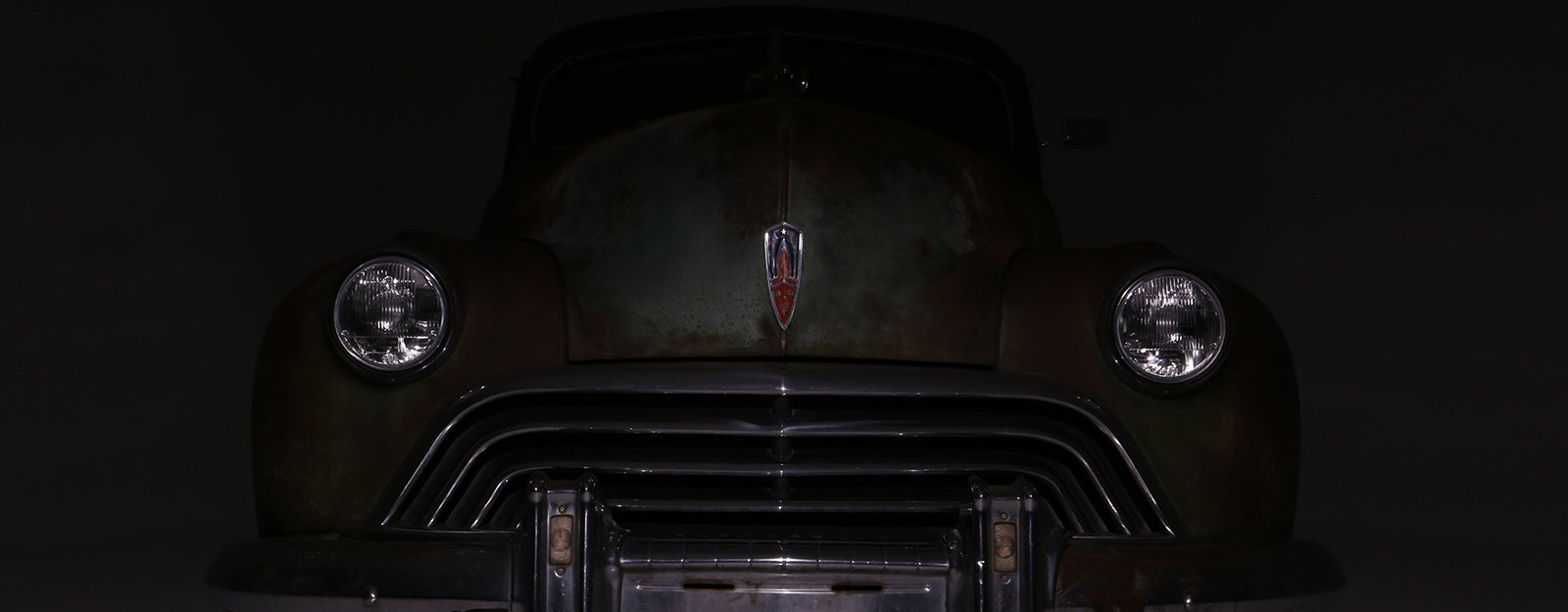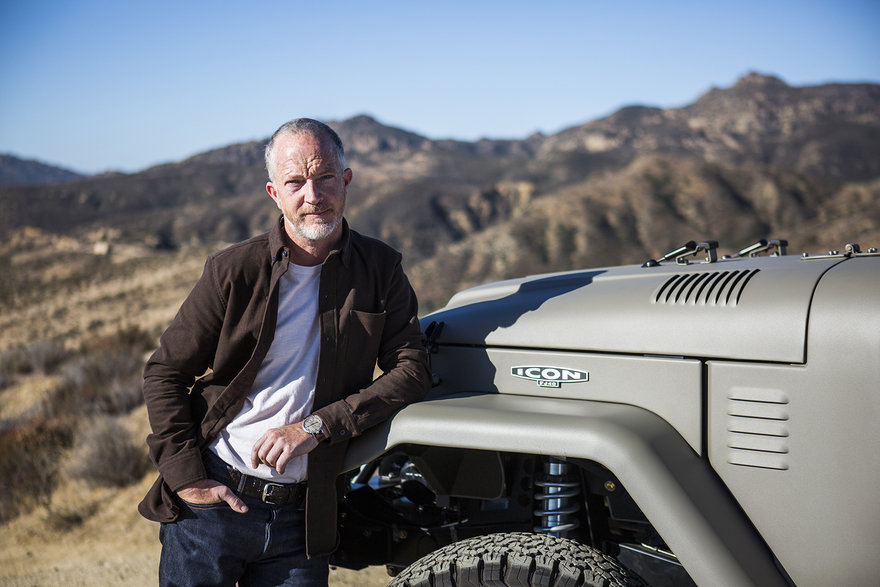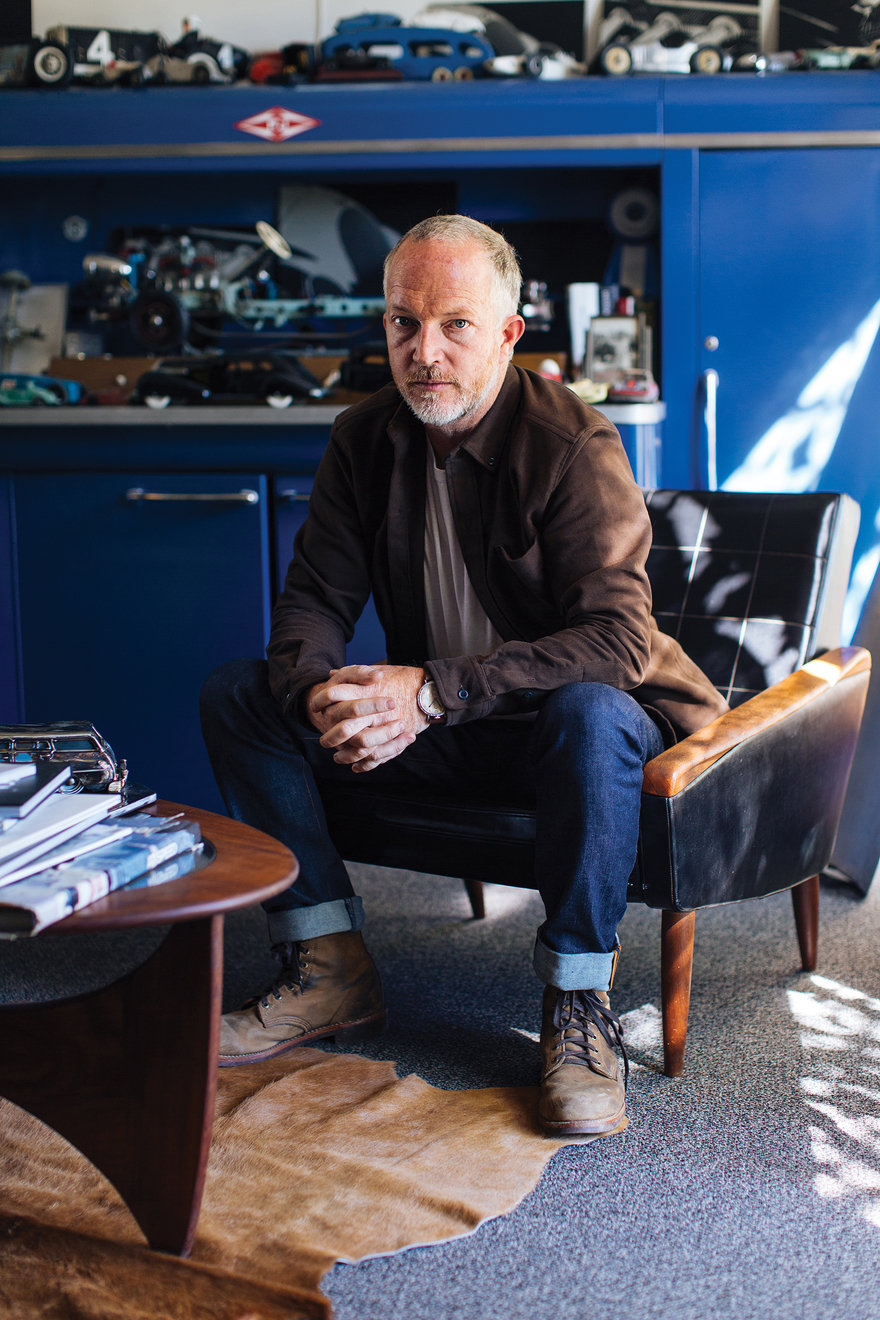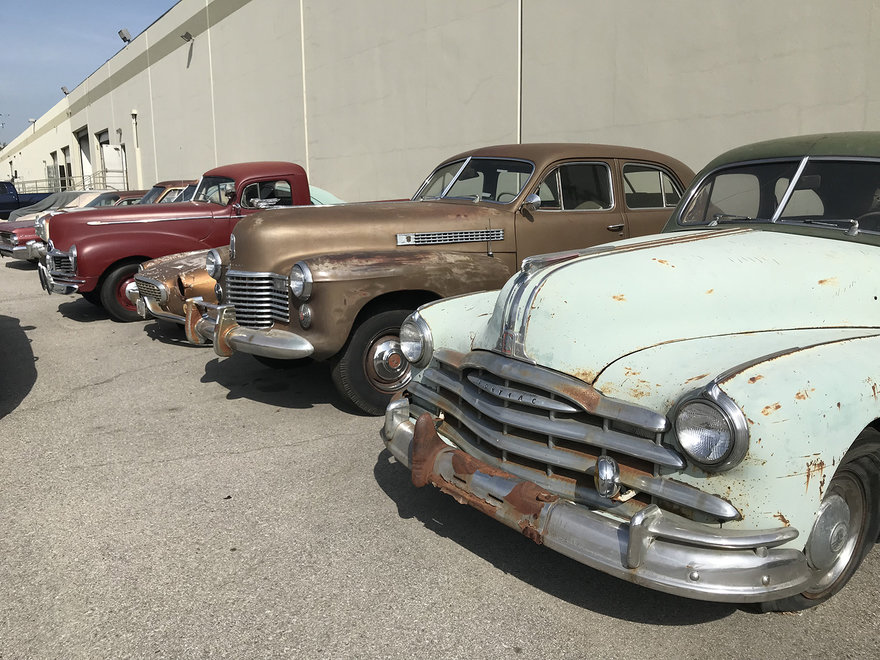
An Interview with Jonathan Ward, Founder of Icon (Part 1)
Design perfectionism on four wheels
Every designer's dream is to create the exact object they envision, unhindered by accountants, marketers and planned obsolescence. Industrial designers among you, think of every project you've worked on where the best engineering and materials were prohibitively expensive; the style needed to be compromised to appeal to a market you had no interest in; and the object couldn't be too durable, because the company needed the customer to come back and buy a new one in five years.
Jonathan Ward has found a way to sidestep these obstacles and, as far as I can tell, he gets to live his dream over and over again.
 Enter a caption (optional)
Enter a caption (optional)Each year Ward and his company, Icon, produce several dozen obsessively-executed four-wheeled design objects with vintage style and 21st-century technology, created from a Bill of Materials so uncompromising that any CFO would march down to your office to have the pleasure of firing you in person.
 Enter a caption (optional)
Enter a caption (optional)Ward's CFO is his wife Jamie, and thus far his job is safe. Twenty years ago the two of them started TLC, a Land Cruiser repair and restoration center that's now the largest in the country. Ten years ago they formed Icon, where Ward could satisfy his urge to create new vehicles precisely the way he wanted to create them, absent compromises. He fixates on every last component and can expound on every design decision he's made, wowing even the most prolific of car collectors (he's been featured on both Adam Carolla's "Carcast" and "Jay Leno's Garage" nearly a half-dozen times each).
 Enter a caption (optional)
Enter a caption (optional)Ward's attention to detail makes Icon's cars expensive. When he encounters a tiny part that the original manufacturer felt was "good enough," and he then finds a part he feels is good enough and it costs nine dollars versus the 30-cent original, guess which one goes onto the BOM. The cars thus start in the $100,000s. Restoration shops that fall short of Ward's insane standards could sell seemingly similar vehicles for much cheaper. "When we started Icon, people said we were nuts," Ward recounts. "They had bets with each other, how long before we're out on the street, bankrupt."
That didn't happen. Turns out there were, and are, a lot of people who are fans of Ward's thorough approach and are willing to pay for its fruits. "Now we see that it's viable," he says, "and we have demand that we have yet to be able to meet."
The waiting list for an Icon is long; order one today, and by the time it's ready your Congressperson may have changed. And while a lot of automakers can produce cars that Tom Hanks, David Letterman or a Saudi Prince are willing to wait for, it's telling that also among Ward's customers are Marc Newson and Sir Jonathan Ive.
 Enter a caption (optional)
Enter a caption (optional)Loosely speaking, Icon turns old cars into new ones. Vastly superior new ones; it's sort of like they start with a shot-up Peter Weller (or Joel Kinnaman, depending on your age) and painstakingly transform him into Robocop. Everything beneath the skin has been redesigned and replaced using modern-day technology, clever engineering, high-end materials and the latest manufacturing methods. The look of the car, and more importantly the spirit, has been preserved; but its design, engineering, performance, and fit-and-finish have been pushed to a level that its original manufacturer couldn't have imagined.
 Enter a caption (optional)
Enter a caption (optional) Enter a caption (optional)
Enter a caption (optional) Enter a caption (optional)
Enter a caption (optional)Icon's Process
The best designers don't just design their products; they design their organization and its processes. In the ten years since Icon's inception, Ward has assembled some 52 fabricators, engineers and technicians with difficult-to-find skillsets (and at least one engineer so deluged with walk-in requests that his door must be kept locked). He has evolved a process that is both high-tech and hands on, CAD work done with dirty fingernails, CNC machines employed alongside craftsmen fitting components by hand.
 Enter a caption (optional)
Enter a caption (optional)A glimpse of Icon's process: Car bodies are removed and laser-scanned. With a digital file created, Ward and his team design a custom-fit chassis accounting for the precise location of the powertrain and engine, which might be the supercharged LS-9 from the Corvette ZR1, Ford's "Coyote" 32-valve V-8, dual electric motors powered by an array of Tesla batteries (divided between front and rear locations for optimal weight balance), or whatever viable powerplant the customer desires.
 Enter a caption (optional)
Enter a caption (optional) Enter a caption (optional)
Enter a caption (optional) Enter a caption (optional)
Enter a caption (optional)The axles, suspension components, brakes, exhaust system, etc. are either custom-built or selected from suppliers renowned for producing the best: Brembo, Borla, Dana, Eibach. Dynamat insulation panels line the insides of the sheet metal, the body undersides are coated with a protective heat-cured polyurea. Scratch-resistant powder-coated paint jobs with custom colors are cooked up. Then there are the fixtures--rearview mirrors, door handles, headlights--all reimagined as if the design brief dictates they must pass MoMA muster.
 Enter a caption (optional)
Enter a caption (optional) Enter a caption (optional)
Enter a caption (optional) Enter a caption (optional)
Enter a caption (optional)"No one has ever applied real craftsmanship to the blank canvas these vehicles can be," Ward says.
 Enter a caption (optional)
Enter a caption (optional)That craftsmanship also extends to the interior of the cars: "There's new opportunities there," Ward explains, "where, depending on the era, the cleanliness and the clarity of the design, we'll go back and redesign knobs, fixtures, trims and textiles.
 Enter a caption (optional)
Enter a caption (optional) Enter a caption (optional)
Enter a caption (optional) Enter a caption (optional)
Enter a caption (optional)"We'll do what we think the original designer would've wanted to do before the focus groups and the accounting department fucked up the details."
 Enter a caption (optional)
Enter a caption (optional) Enter a caption (optional)
Enter a caption (optional) Enter a caption (optional)
Enter a caption (optional) Enter a caption (optional)
Enter a caption (optional)We had the opportunity to interview Ward and visit his 76,000-square-foot facility in Chatsworth, outside Los Angeles. Here in Part 1 we discuss how and why Ward does what he does, what makes Icon viable, how digital tools and CAD figure into his process and more.
 Enter a caption (optional)
Enter a caption (optional)Core77: The cocktail party question: How would you describe to a stranger what you do?
Jonathan Ward: I would struggle with that because I'm a self-appointed designer, but in all honesty, I have no degrees or rights to call myself one. But I've always been driven by industrial design. I'm constantly geeking out on everything around me, surfaces, textures, shapes, forms.
Where do those compulsions come from?
I don't know. As a young kid I lived on a farm in Elkridge, Maryland and then we moved to New York City, where I was suddenly overwhelmed with input from architecture and design. And I was always sketching and tinkering. My hobbies over the years have included sculpting in stone and in marble, woodworking, Pre-Raphaelite painting. And now leathercraft is a current major weekend obsession.
How long have you been interested in transportation?
Ever since I was little. My granddad had a corner car repair dealership spot in a small town in Virginia that we'd visit. He'd shuttered it before I was born but still owned the property, it was frozen in time, boarded up and still had cars stored inside. So there was something romantic about that to me. I was constantly geeking out on vintage cars and learning about them by taking them apart. When I was around 16 I started [amassing] a huge library of biographies and autobiographies of historic automotive pioneers. The business ethics and the visionaries in the transportation sector from decades ago always excited me, as did the designs, far more than what was coming out new.
 Enter a caption (optional)
Enter a caption (optional)And travel's always been a big thing for me. So being hyper-cognizant of all these different inputs, and having a lot of those different skills, I quickly found that transportation design was the most interesting and extroverted combination of all of the shit I love and am fairly competent at.
So that's how I found my space. But, yeah, what do I tell people? I tell them I'm a designer and have a small car company. And, in a nutshell, I try and tell people that I'm all about revisiting classic design in a modern context, be it transportation, or my watches, or other things that I don't do professionally yet. That seems to be the DNA, the theme amongst all the crazy shit I'm into.
 Enter a caption (optional)
Enter a caption (optional)You already had a successful business with TLC, your Land Cruiser repair business. What made you start up Icon?
I had a very clear vision of wanting to do things my way, when it comes to what I see as [the automotive space's] missing continuity in design and engineering. Also, the lack of engineering I see, where guys are building "Johnny Cash Specials," [borrowing] a bit from here, a bit from there. I don't understand it. At the end of the day, [that kind of] engineering is going to be self limited, because it's like trying to redo a house comprehensively without tearing it down to the chimney. There's too many constraints, and you're never going to get it there.
So the whole founding principles of Icon were: I didn't like the status quo, the established genres/segments that the [custom auto] market had stuck themselves in. Same with the engineering limitations: What's good enough? What's acceptable?
Thirdly I also wanted to take the mom-and-pop resto-mod shop and get it out of the Stone Age. Obviously, that references the other priorities of creating principles and aesthetic, and founding engineering concepts that are consistent across the brand, but also to be far heavier in CAD. In this industry, at this level, hardly anybody's in CAD, laser scanning, reverse engineering.
 Enter a caption (optional)
Enter a caption (optional)I saw these opportunities around the same time that Bertone, Figoni et Falaschi and all these amazing storied custom body houses were going out of business. Disappearing at a time when the technology--the CAD evolution, 3D printing, hydroforming, on and on--was coming together, and you can do that [kind of work] at a higher level, quicker and more effectively, than any time in our manufacturing history. It didn't make sense to me. So I wanted to pull all of that together.
For the CAD users in our readership, is there any software or digital tools that you find indispensable?
Traditionally we've been a SolidWorks shop, but Fusion 360 is a downright game changer. With no plug-ins, its ability to communicate direct with machining, CAD/CAM, 3D printing, then the truly beautiful surface rendering capabilities--I love it. We've recently transitioned many projects over to it, but not all because the program is still recent and not fully developed to handle large-scale assemblies.
And FARO's latest blue laser scanners kick ass. MAKEiT 3D have become friends--I don't know if it's public yet, I think it is--they have a new large format printer that's kickass. So we've been working with them, prototyping parts.
Our shop is what makes our weird model able to exist. It's such a geek mash-up of super low-tech tools from 1910, to a 5-axis CNC and laser scanning [rigs]. We're total MacGyvers, because we have to be to make this crazy shit viable.
 Enter a caption (optional)
Enter a caption (optional)About how many cars have you done since inception, and how many cars do you have on the floor at any given time?
Just through Icon, about 200, 210 vehicles thus far. Through TLC would be a confusing thing to answer--we do everything from a less comprehensive power train update through to a full resto, so it's much harder to track. But on restorations, maybe a thousand.
At Icon I have 21 active on the floor, and 76 sold and on the list, waiting their turn to be worked on.
That's a lot of cars. Can you talk about the difference between the one-offs and the models you repeat, so to speak?
So what makes the company viable is our production models, using the term as lightly as possible, of the BR, the FJ, and the TR. The BR is the '60s Bronco-inspired build.
 Enter a caption (optional)
Enter a caption (optional)We have the FJ, which is based on the old Toyota Land Cruisers.
 Enter a caption (optional)
Enter a caption (optional)And we have the TR, which is the Thriftmaster, based on the '47 to '53 Chevrolet truck.
 Enter a caption (optional)
Enter a caption (optional)So those, we repeat. And instead of handmaking a bracket every single time, we handmade that bracket for the first five or six trucks. We kept geeking, and tweaking, and refining, until it was exactly the best form we thought it could be. Then we revised that CAD file. We're in an old aerospace area, so I have them made [locally], and they're in stainless, and TIG-welded, and laser cut, and far more consistent. So they're more cost effective, and more identical/repeatable, allowing us to get more scale and perfection in our build.
 Enter a caption (optional)
Enter a caption (optional) Enter a caption (optional)
Enter a caption (optional)Then you have the one-off division, which really keeps me entertained--it's like a customer-funded skunkworks. That's where we do the Derelict and Reformer vehicles, which are one-of-one, every single time. Those are fun as hell. They're also stupid business. At the end of the year, if we clear 5% net on them, it was a good year.
So they're just dumb, because the amount of resources--they tie up my engineering department, they tie up the CNC department, they take up the most skilled fabricators and the floor space. But they're the most important for us to be constantly innovating, and learning, and testing new platforms, new materials, new power train solutions... And they're fun, fun, fun.
 Enter a caption (optional)
Enter a caption (optional)How do CAD and digital tools figure into the process?
In the design and engineering review phase, we'll generally do a full 360 laser scan of the body structure so we have it in CAD. Because obviously they [don't exist for a lot of these cars]. Then we do a pretty detailed design review with the client, including mechanical stuff, cosmetic principles, some rough sketches, in some cases whole renderings, depending on the client's ability for me to babble my vision--[some are like] "Hey, I can picture it, fuck yeah, let's go," [others say] "That sounds cool, but I really need to see it."
And then I work with a couple people, must notably with Eric Black of E. Black Designs. Fucking rock star. So I'll work through that with him, produce the rendering, the outline, go back to the client, get approval, take a deposit. Then what kills me is it sits, because the backlog is so long before we're ready.
And then, usually about six months before we're really ready to put labor, boots on the ground on it, me with my engineers will work through all the details and have it all locked down.
I firmly believe you've got to know where you're going, what the end goal is, before you start anything with a job. You can't just start taking shit apart without really understanding the end goal.
 Enter a caption (optional)
Enter a caption (optional)_____________________
Read more in Part 2, where we discuss: Product longevity, how to future-proof something as complicated as a car, how to reconcile custom manufacturing with ease-of-repair, what the mass-market auto industry gets wrong and more.
-
oFavorite This
-
Q2Comment
K
{Welcome
Create a Core77 Account
Already have an account? Sign In
By creating a Core77 account you confirm that you accept the Terms of Use
K
Reset Password
Please enter your email and we will send an email to reset your password.


Comments
Eagerly waiting for part 2.....
Awesome series! Excited for part 2.